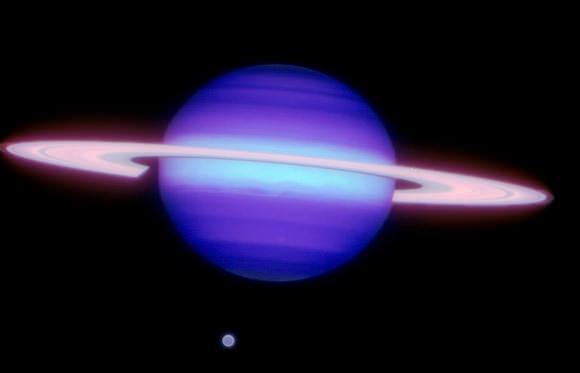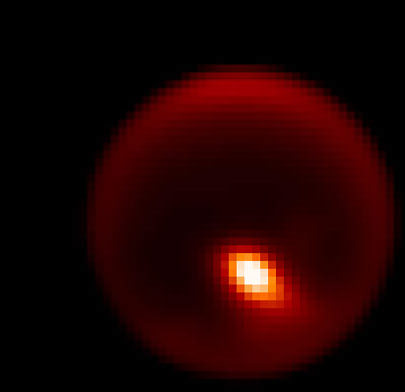[/caption]
Titan is just fun. Seems like every other week, another fascinating tidbit emerges about how interesting Saturn’s famous moon really is — and how compellingly similar to Earth.
A United States team of astronomers is releasing this image today in Nature. It’s an adaptive optics peek at a storm over the wild object’s parched, dry desert.
The new research, to be published in the August 13 issue of the journal, announces the discovery of significant cloud formation (about three million square kilometers, or 1.16 million square miles) within the moon’s tropical zone near its equator. Prior to this event (in April 2008) it was not known whether significant cloud formation was possible in Titan’s tropical regions. This activity in Titan’s tropics and mid-latitudes also seems to have triggered subsequent cloud development at the moon’s south pole where it was considered improbable due to the Sun’s seasonal angle relative to Titan.
The evidence comes from astronomers using the Gemini North telescope and NASA’s Infrared Telescope Facility (IRTF), both on Hawaii’s Mauna Kea.
“We obtain frequent observations with IRTF giving us a ‘weather report’ of sorts for Titan. When the IRTF observations indicate that cloud activity has increased, we are able to trigger the next night on the Gemini telescope to determine where on Titan the clouds are located,” said team member Emily Schaller, who was at the University of Hawai‘i Institute for Astronomy when this work was done.

Titan, the solar system’s second largest moon, has received considerable attention by scientists since NASA’s Cassini mission deployed the Huygens probe that descended through the moon’s atmosphere in January 2005. During its descent, the probe’s cameras revealed small-scale channels and what appear to be stream beds in the equatorial regions that seemed to contradict atmospheric models predicting extremely dry desert-like conditions near the equator. Until now these erosional (fluvial) features have been explained by the possibility of liquid methane seeping out of the ground.
“In April 2008 we observed what was a global event that shows how storm activity in one region can trigger clouds, and probably rainfall, over arid regions, such as the tropics where Huygens landed,” said team member Henry Roe, an astronomer at Lowell Observatory. “Of course these rain showers are not liquid water like here on Earth, but are instead made of liquid methane. Just like the streambeds and channels that are carved by liquid water on Earth, we see features on Titan that have been created by flowing liquid methane.”
Unlike the Earth, on Titan, where the temperature is hundreds of degrees below freezing, methane (or natural gas) is a liquid and it the dominant driver of the moon’s weather and surface erosion. Any water on Titan is frozen on or below the moon’s surface and resemble rocks or boulders on Titan’s surface.
Mid-latitude and polar cloud formations have been bserved for many years (by this team and others) but the combination of extensive monitoring at the IRTF with rapid follow-up using Gemini allowed the team to capture the process as it unfolded near the equator. The team monitored Titan on 138 nights over 2.2 years and during that time cloud cover was well under one percent. Then, mid-April of 2008, just after team member and Ph.D. candidate Schaller had handed in her doctoral dissertation focusing on Titan’s minimal cloud cover she noticed the dramatic increase in cloud cover.
During this three-week episode clouds forming at about 30 degrees south latitude were observed, followed several days later by clouds closer to the equator and at the moon’s south pole. The apparent connection between the cloud formations leads to the possibility that cloud formation in one area of the moon can instigate clouds in other areas by a process known as atmospheric teleconnections. This same phenomena occurs in the Earth’s atmosphere and is caused by what are called planetary Rossby waves which are well understood.
The high-resolution Gemini images of Titan were all obtained with adaptive optics technology which uses a deformable mirror to remove distortions to light caused by the Earth’s atmosphere and produce images showing remarkable detail in the tiny disk of the moon.
“Without this technology this discovery would be impossible from the surface of the Earth,” said Schaller. Currently the Cassini spacecraft is orbiting Saturn but only flies by Titan once every 6 weeks or so. This makes continuous ground-based monitoring important for studying features like these with shorter periods on the order of 3-weeks like this storm.
Further detail about the lead image: Gemini North adaptive optics image of Titan showing storm feature (bright area). Titan is about 0.8 arcsecond across in this 2.12 micron near-infrared image obtained on April 14, 2008 (UTC). CREDIT: Gemini Observatory/AURA/Henry Roe, Lowell Observatory/Emily Schaller, Insitute for Astronomy, University of Hawai‘i
Source: Gemini. Other information available through the University of Hawaii, the National Science Foundation (NSF), Lowell Observatory in Flagstaff, Arizona and, of course, Nature.


Might this feature be due to cryovolcanism occurring on Titan? Triton also seems a likely place for this type of phenomenon.
@John Hanford: I’d concur with your supposition of cryovolcanism causing this feature. It may also explain the cloud formations. Hopefully Cassini can provide more detailed proof in the future. Btw, what is your background, astrophysics, astronomy? I’ve just discovered this site in the last couple months and am learning a great deal from your posts.
What a wonderful photo of Saturn and Titan!
Is there any word on weather the “storm” is moving in relation to Titan’s surface?
I’m also wondering if the equinox of the Saturn system has any effect on Titan’s weather.
No matter the cause, this is truely amazing!
The feature is pretty huge to have any sort of volcanic origin in my opinion.
@ Anne Minard,
At paragraph 8, line 2:
That should be: methane (or natural gas) is a liquid and it is the dominant driver of the moon’s weather and…
Also, there’s a typo at paragraph 9, in line 1; it should be: observed, not “bserved”. 🙂
it’s so strange to think of liquid methane rain falling down. my spock mode says ‘fascinating’
Might this event in Titan’s atmosphere possibly be due to an external impactor (asteroid, comet, etc.) similar to the recent impact event seen in Jupiter’s atmosphere. IIRC, that ‘spot’ had a warm IR signal originating in the lower cloud deck. Just more speculation FWIW. Any visible-light images of Titan showing this region of its atmosphere. Just a large ‘storm’ or cloud system also seems in the running, as Dark Gnat has suggested.
@William 928, I discovered this site rather recently , too (~18 months ago?). I too, was attracted by the depth of the threads posted at many of the articles. As for my background, I took the usual 4 year undergrad courses at OSU in the late 70’s with a major in astrophysics and a minor in physics, for which I received my B.S. in astrophysics in 1980. Due to the national recession at the time, I ended up working for an electronics firm. But since then, my interest in both amateur and pro astronomy has only intensified. My main areas of interests include galaxies (especially interacting systems) galaxy clusters and superclusters, Black Holes (both large and small), dwarf galaxies, globular clusters and their dynamics and pretty much everything else as it relates to astronomy. You will find many knowledgeable contributors to this site with many specialized interests. Part of the fun of following UT post and stories is that I learn something new almost every time. This makes time spent perusing UT well spent. Hope to hear more from you in the future & have fun 🙂
From Andrew CABANES:
We are never sure about our future, but thanks to these kinds of discoveries, our children or grand children will be grateful to us for deeply investigating so hard into the universe and just imagine:we are in our infancy
@John Hanford: Thank you for taking the time to respond. My educational background is not in physics or astronomy, but I have a great deal of interest in all things related to the universe. I’ll continue to learn from this site and post occasionally if I have anything meaningful to add.
you’re right anne: titan *is* just fun. it’s in my top 3 most interesting bodies in the solar system.
we’re so fortunate to live in an era where we are discovering for the first time these features which have the potential to be watched and studied for centuries to come.